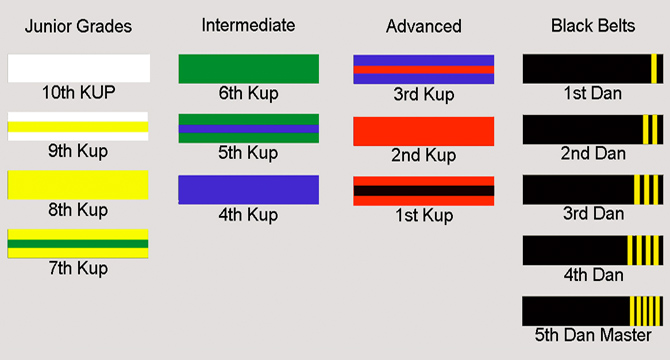Belts Ranking
As a student progresses in his Taekwondo learning he will ascend in terms of skill and seniority through the organisation. Taekwondo practitioners are divided into three levels: Junior, Senior and Instructor.
Junior Level
At the Junior level, a Taekwondo student's progress is marked by his attainment of coloured belts. The beginners belt is white and the highest level of achievement is a black belt. In order to progress from one belt to the next the student must undergo grading exams, known in Taekwondo as promotion tests. A promotion test will involve the demonstration of his learning to date and a strict curriculum demands that he show his experience inpoomsae (forms) and breaking. Breaking boards successfully will demonstrate power and speed of his techniques while poomsae will prove his memorisation of individual techniques in a set sequence.
The Taekwondo student may also need to answer questions given by the panel of judges and in later tests, submit research papers and/or complete written exams. In the junior level promotion, exams come around fairly quickly (every 3 to 4 months), allowing rapid ascension for dedicated students. Each ascending level is known as a geup, or kup and there are ten in the junior section. Each belt has a different colour with its own symbolic meaning.

White Belt (10th Kup) - White signifies the innocence of the beginner and his ignorance of Taekwondo.
White Belt with Yellow Stripe (9th Kup)
Yellow Belt (8th Kup) - Yellow represents the earth, from where a plant takes root and sprouts as the foundations of Taekwondo are laid.
Yellow Belt with Green Stripe (7th Kup)
Green Belt (6th Kup) - Green signifies the plant itself as, like a plant, the student's Taekwondo skills continue to grow.
Green Belt with Blue Stripe (5th Kup)
Blue Belt (4th Kup) - Blue represents the heavens above, the divine direction in which the plant is growing.
Blue Belt with Red Stripe (3rd Kup)
Red Belt (2nd Kup) - Red signifies danger, warning the student of his own capability for damage and other students of his skill.
Red Belt with Black Stripe (1st Kup)
When a student reaches Black Belt (1st Dan) he is considered to be a senior. Black is the opposite of white and therefore signifies the student's maturity and skill. It also signifies his mastery over darkness - that he is no longer afraid of evil or fear itself. From here on in the belts no longer change colour.
Senior and Instructor Levels
Senior levels are marked by progressing up through Dans. Promotion tests are much more difficult and dan grades may only be moved after number of years, rather than months. Although the belt remains black, a dan grade may be marked with white stripes, roman numerals, or nothing at all - it depends on the school. There are 9 dan grades in total and they are grouped into levels of responsibility, each with a corresponding title as follows:
Novice (1st - 3rd Dan) is an Assistant Instructor or Boo-Sabum.
Expert (4th - 6th Dan) is an Instructor or Sabum.
Master (7th- 8th Dan) is a Master or Sahyun.
Grand Master (9th Dan) is a Grand Master or Saseong.






